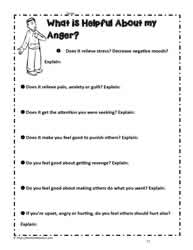
Allow students to role play the position of the person they sometimes get angry at in order to help them understand how the other person may feel. I structure my class so that pupils know what to expect on a daily basis.

Cooling-Off Strategies to Diffuse a Situation.
Anger management strategies for students. Second breathing in a certain way slowly and deeply so deeply that your belly moves too and in through your nose and out through your mouth can often help people who are angry to begin to calm down. Take a walk or step away. Change the environment by taking a walk or stepping away if you can.
Helpful strategies to help young learners discover constructive ways to deal with anger management. Classroom Structure Can Lead to Success. I structure my class so that pupils know what to expect on a daily basis.
Cooling-Off Strategies to Diffuse a Situation. When I sense a student. Effective anger management means giving students coping strategies to manage their anger and frustration in healthy respectful ways when those difficult feelings arise.
If something is making you feel angry frustrated or overwhelmed its a. Anger Management Strategies Identify Triggers. If youve gotten into the habit of losing your temper take stock of the things that trigger your.
Before you spring into action to calm yourself down ask yourself if your anger is a friend or an. Lets take a look at some anger management strategies that are particularly effective with elementary students. Distraction from the Source Sometimes students can be distracted from what is.
Fill a box with items that can help them calm down such as a coloring book and crayons lotion that smells good or soothing music. Engaging their senses can help calm their mind and body. Use time-out as a tool to help your child calm down.
Resources for Students with Anger Management Angry Paper Toss. Provided by Kims Counseling Corner this activity can help students share what makes them angry. Gather large white paper markers napkins tape and a container of water.
Tape the paper somewhere like. A calm down corner is a great place for students to complete their Anger Journal or Anger Management Activities. The Chill Spot provides a specific location that is comfortable and calming for students.
Check out my calm down corner ideas and calm down corner printables right here Anger Management Read-Alouds. Read a book with the student. TEACHERS PARENTS.
Acknowledge that anger can be perfectly normal and healthy for children if it is expressed appropriately. Acknowledge students feelings and let them know that they are valid and that you understand. Students should know that being angry is okay but that there is an appropriate.
Anger worksheet describes six techniques for managing anger. Some of these skills can help to prevent or minimize explosive anger such as triggers and warning signs. Other skills are intended to take control of anger such as diversions time-outs and deep breathing.
The 12 anger management strategies are. Count backwards from 10. Take 3 deep breaths.
Exercise or play to let off some steamenergy. Find a quiet place. Tell yourself calming statements.
Relax Lie down and relax. Tense your body- then relax it. Not all children will respond to the strategies for anger management.
Students cannot always relate their feelings surrounding angry outburst. Finding the right approach to anger management can be a little tricky. Young students may respond well to worksheets games and passive activities.
These can be used effectively to teach anger management. Heres a collection of the best tools and tips to teach children how to manage their anger in safe and healthy ways. Lets start with some quick safe ways to help kids express those feelings.
Quick Ways to Help Kids Express Their Anger. Wrap your arms around yourself and squeeze. Write a letter to someone.
Now that youve learned more about anger and how you respond to it you can develop your own plan for managing your anger. Set positive goals and a time frame Your goals should address both a specific behavior and your reaction. Related 4 Things to Try When Your Angry Child Refuses Coping Strategies.
Our anger is a part of us but it doesnt have to control us. Anger is a powerful emotion and often feels overwhelming and unsettling for kids. A fantastic therapist tool I use often with kids is externalizing a problem or challenge a child is.
Here are a few other anger management techniques you can teach students. Allow students to role play the position of the person they sometimes get angry at in order to help them understand how the other person may feel. This can help them to see the other side of the situation and to empathize with the person they are angry at.
Having a consistent behaviour policy is only part of the answer. Being able to help pupils identify their emotional social and academic needs is the foundation for positive change. With the introduction of anger management strategies that pupils can own and adapt there is a much greater possibility of creating better outcomes.
Students watch to see how the birds respond when their eggs are taken away. After watching we reflect as a group. Then I assign each student a bird and they have to come up with a positive choice they could make when angry.
Students can write andor draw their responses.